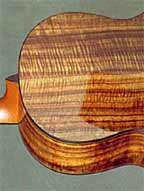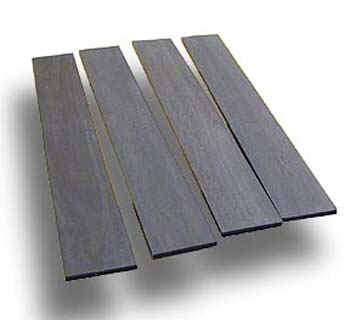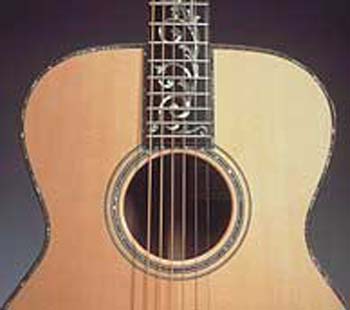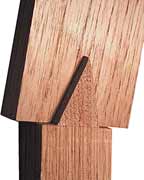Guitar Tonewoods for Luthiers
HOME ORDER ONLINE PRODUCTS REGISTER CONTACT US




Backs & Sides Fretboards, Headplates, Bridge Blanks, Bridge Pins Soundboards Neckblanks, Binding, Purfling, Rosettes, Veneers What makes a tonewood? I don't remember where I heard or read it, but it went something like: "true tonewoods seem to be of an unusually felicitous combination of beauty, taptone, integrity, stability, and mystique." There is a better than average chance that I made this up, but no matter. In fact, lots of guitars have been made from woods that have none of these characteristics. We would like to find most of the same desirable traits in backs and sides that we find in the best soundboards: straight, even grain, 15 - 25 grain-lines per inch, perfectly quarter sawn, showing lots of medullary ray, no run-out, stiff, no color variation (some people like this in backs and sides, others prefer colorful). In a soundboard that conforms to these ideals, it would surely cover the unusually felicitous combination mentioned above. Even mystique, which might have been reserved for those backs and sides that came from the small Indonesian island of North Maluku, is reasonably applied to a beautifully lustrous top. Woody Allen wrote "that of all of God's creations, perhaps the tree was the most remarkable, but how did he get the bark on." Or how did God make these guitar woods perfect, or sufficiently perfect, anyway?
In backs and sides, almost every type of wood has been used, including oak, juniper, plywood, and even pallet wood and particle board, often with good results. In some of our back and side offerings, we can mention a number of guitar woods that might have only one or two of the unusually felicitous qualities, but make for great sounding guitars. Bigleaf maple, for example, does not have much of a taptone, is not as stable as many tonewoods, and there's not too much mystique surrounding it; Indian rosewood covers most of qualities, but it too, has little mystique because it has been the de facto back and side guitar wood for the last forty years by most manufacturers. Is there one tonewood in a back and side set that would qualify for this unusually felicitous combination? No, there is not one, there are many. But it is getting harder and harder to obtain them in quantity and maintain the consistent quality that translates to integrity and stability.
As an aside, most of the other guitar woods that go into the mix (bridge blanks, headplates, bracewood, neck blanks, fingerboards) would like to boast the same high qualifications: quartersawn, fine-, even-, straight-, grained, no knots, no pinholes (this last becoming more and more acceptable), and attractive.
Address General Information Sales/support Telephone: 707-431-3760 POB 217, 101 C Grant Avenue, Healdsburg, Ca. 95448 USA [email protected] [email protected] Fax:
707-431-3762

